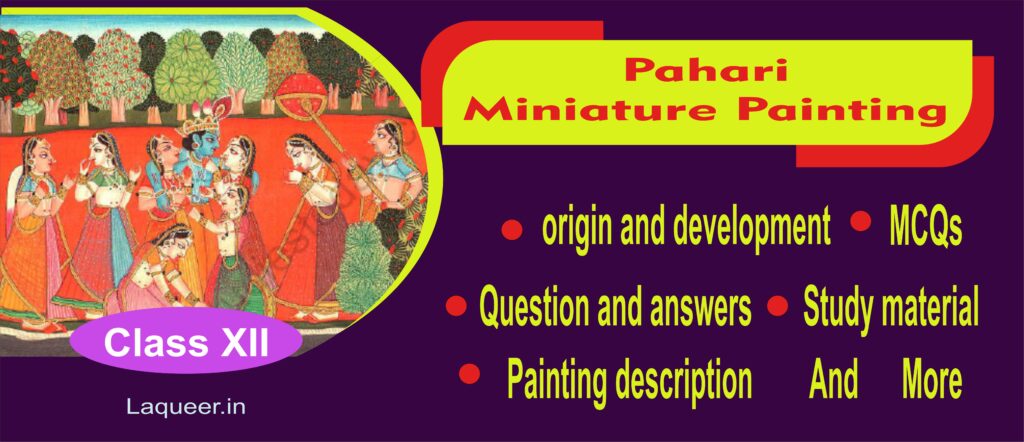
Pahari School of Miniature Painting
An Enchanting Journey through Time
Introduction
In the serene hills of the Indian subcontinent, a remarkable artistic tradition blossomed and thrived—the Pahari School of Miniature Painting. Originating in the 17th century, this unique art form has captivated art connoisseurs and enthusiasts alike with its delicate beauty and intricate craftsmanship. Let’s embark on a journey through the origins, development, and main features of the Pahari School of Miniature Painting.
Origins and Influences
Guler is supposed to be the place of origin of Pahari school of miniature painting according to different scholars. some scholars consider Basohli as the origin of Pahari school of miniature painting.In 1780 A.D. the GULER KALAM was its peak. Then entered Kngra and came to be known as KANGRA KALAM.
Auranzeb was the cruel Mughal ruler. He hated painting and music .so most of the Mughal artists went to hills where they got shelter and there they invited s different new style of painting known as Pahari miniature painting .in the beginning, Pahari school flourished as a folk art, it came to be known as a Pahari kalam.
Some scholar considers Guler as the palace of origin of Pahari school of art for many different reasons. firstly, the kings of Guler had friendly relation with Mughal emperors. There can be the possibilities that the artist from Guler might have shifted to Guler as it was nearer place for shelter and they might have renewed the folk art of Guler by adding some newness to it.
Some scholars consider that due to Aurangzeb’s cruelty, Mughal artists might have shifted to Basohali and according to them, Basohali which flourished under Raja Kripal Pal is the origin place of Pahari school.
The oldest Kangra painting are connected with Guler where raja Goverdhan Chandra and his family has been depicted. after him raja Prakas Chandra and then raja Bhoop Singh came into power. then under raja Sansar Chand’s Protonege, finest paintings were created. the Raja Sansar Chand’s period is considered to be the golden period of KANGARA KALAM.
Feature
The Pahari School of Miniature Painting emerged in the hilly regions of the present-day states of Himachal Pradesh, Jammu and Kashmir, and Uttarakhand, India. The word “Pahari” translates to “of the hills” in Hindi, and this artistic style drew inspiration from various sources, including the Mughal, Rajput, and Persian schools of painting.
The earliest Pahari paintings were influenced by the Mughal style, reflecting the finesse of the imperial courts. As time passed, local flavors and elements from the Rajput traditions started to seep into the art, giving birth to a distinct and harmonious fusion.
Main Features of Pahari School Paintings
1. Miniature Scale:
True to their name, Pahari paintings are miniature in size, usually ranging from 3 inches to 8 inches. Despite their small dimensions, they exude immense artistic brilliance.
2. Natural Pigments:
Pahari artists employed natural pigments derived from minerals, plants, and even precious stones to create a stunning palette. These organic colours lend the paintings a unique and timeless charm.
3. Intricate Details:
One of the most captivating aspects of Pahari paintings is the intricate detailing of jewelry, clothing, and facial expressions. This attention to detail brings life and depth to the characters portrayed.
4. Storytelling Narratives:
The Pahari School of Miniature Painting narrates fascinating stories through its artwork. These tales often revolve around religious deities, folktales, and romantic escapades, connecting the viewer to the rich cultural heritage of the region.
Conclusion
The Pahari School of Miniature Painting stands as a testament to the timeless artistic brilliance that emerged from the serene hills of India. With its captivating blend of Mughal, Rajput, and Persian influences, this art form continues to mesmerize art lovers worldwide. The Basohli, Kangra, and Guler schools, with their distinct styles and themes, collectively form an enchanting journey through time and culture. The delicate beauty, intricate detailing, and storytelling prowess of Pahari paintings transport us to an era of artistic splendour and creative expression, leaving an indelible mark on the annals of art history.